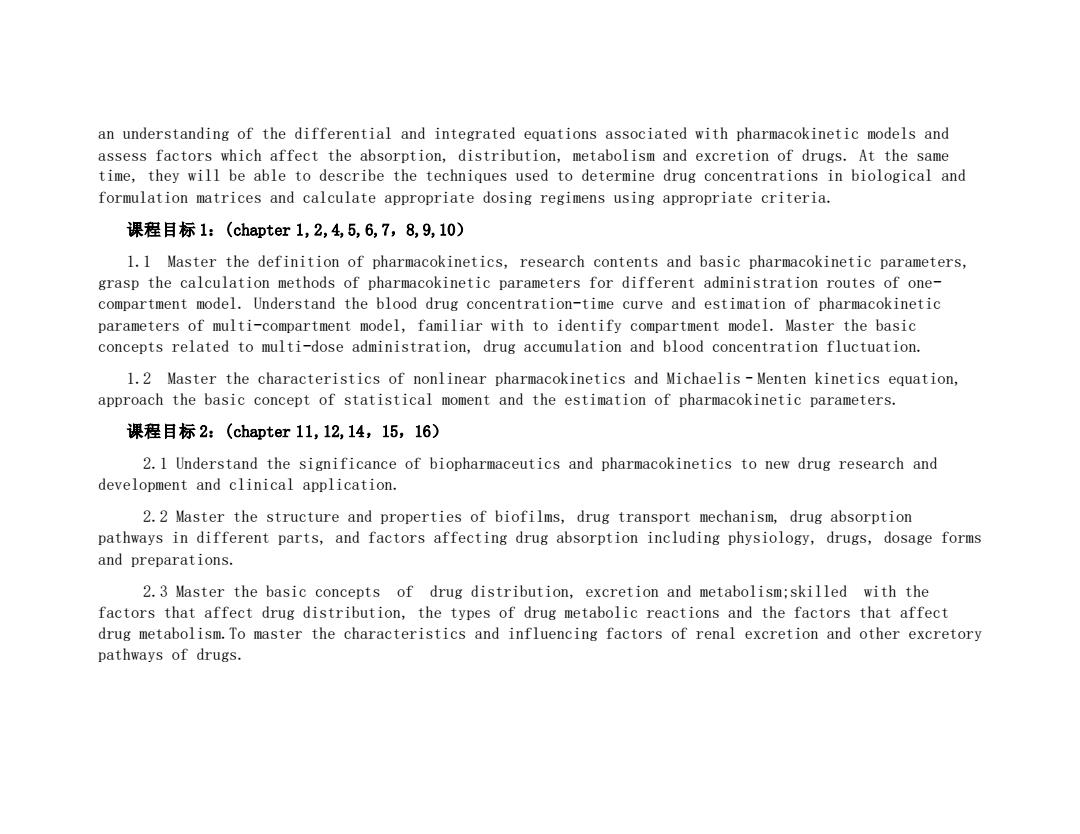正在加载图片...

an understanding of the differential and integrated equations associated with pharmacokinetic models and assess factors which affect the absorption,distribution,metabolism and excretion of drugs.At the same time,they will be able to describe the techniques used to determine drug concentrations in biological and formulation matrices and calculate appropriate dosing regimens using appropriate criteria. 课程目标1:(chapter1,2,4,5,6,7,8,9,10) 1.1 Master the definition of pharmacokinetics,research contents and basic pharmacokinetic parameters, grasp the calculation methods of pharmacokinetic parameters for different administration routes of one- compartment model.Understand the blood drug concentration-time curve and estimation of pharmacokinetic parameters of multi-compartment model,familiar with to identify compartment model.Master the basic concepts related to multi-dose administration,drug accumulation and blood concentration fluctuation. 1.2 Master the characteristics of nonlinear pharmacokinetics and Michaelis-Menten kinetics equation, approach the basic concept of statistical moment and the estimation of pharmacokinetic parameters. 课程目标2:(chapter11,12,14,15,16) 2.1 Understand the significance of biopharmaceutics and pharmacokinetics to new drug research and development and clinical application. 2.2 Master the structure and properties of biofilms,drug transport mechanism,drug absorption pathways in different parts,and factors affecting drug absorption including physiology,drugs,dosage forms and preparations. 2.3 Master the basic concepts of drug distribution,excretion and metabolism;skilled with the factors that affect drug distribution,the types of drug metabolic reactions and the factors that affect drug metabolism.To master the characteristics and influencing factors of renal excretion and other excretory pathways of drugs.an understanding of the differential and integrated equations associated with pharmacokinetic models and assess factors which affect the absorption, distribution, metabolism and excretion of drugs. At the same time, they will be able to describe the techniques used to determine drug concentrations in biological and formulation matrices and calculate appropriate dosing regimens using appropriate criteria. 课程目标 1:(chapter 1,2,4,5,6,7,8,9,10) 1.1 Master the definition of pharmacokinetics, research contents and basic pharmacokinetic parameters, grasp the calculation methods of pharmacokinetic parameters for different administration routes of onecompartment model. Understand the blood drug concentration-time curve and estimation of pharmacokinetic parameters of multi-compartment model, familiar with to identify compartment model. Master the basic concepts related to multi-dose administration, drug accumulation and blood concentration fluctuation. 1.2 Master the characteristics of nonlinear pharmacokinetics and Michaelis–Menten kinetics equation, approach the basic concept of statistical moment and the estimation of pharmacokinetic parameters. 课程目标 2:(chapter 11,12,14,15,16) 2.1 Understand the significance of biopharmaceutics and pharmacokinetics to new drug research and development and clinical application. 2.2 Master the structure and properties of biofilms, drug transport mechanism, drug absorption pathways in different parts, and factors affecting drug absorption including physiology, drugs, dosage forms and preparations. 2.3 Master the basic concepts of drug distribution, excretion and metabolism;skilled with the factors that affect drug distribution, the types of drug metabolic reactions and the factors that affect drug metabolism.To master the characteristics and influencing factors of renal excretion and other excretory pathways of drugs